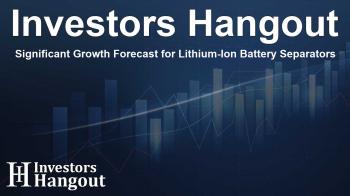Significant Growth Forecast for Lithium-Ion Battery Separators

Exploring the Lithium-Ion Battery Separator Market Growth
The lithium-ion battery separator market is on the brink of remarkable growth. Recent analyses indicate an impressive annual growth rate of 19.1%, with estimations suggesting the market will expand to approximately US$ 24.3 billion by 2030. Such substantial growth is primarily driven by the ongoing advancements and demands in multiple sectors, particularly electric vehicles (EVs) and renewable energy storage.
Market Insights and Projections
According to recent data, the demand for lithium-ion batteries is surging due to their critical role in powering the modern world. Factors such as increased adoption of electric vehicles and the push for sustainable energy solutions are vital in shaping this market. Stratview Research indicates that between 2024 and 2030, the market is set to evolve significantly, supported by technological innovations ensuring safety and efficiency.
Key Drivers Influencing Market Growth
Several elements are propelling the lithium-ion battery separator market forward. The rapid expansion of the electric vehicle market is perhaps the most notable driver, as these vehicles rely heavily on efficient battery technology to deliver high performance. Moreover, the deployment of renewable energy solutions like solar and wind energy storage systems is anticipated to increase the demand for reliable and durable battery separators.
Continuous advancements in battery technology are paving the way for improved performance at reduced costs. Safety regulations are becoming increasingly stringent, encouraging manufacturers to enhance the reliability of their battery components.
Material and Separator Type Analysis
The lithium-ion battery separator market is divided into several categories based on material and separator type. When considering material types, polyethylene (PE) remains the preferred choice among manufacturers due to its high purity, strength, and chemical stability. The unique properties of PE, especially UHMWPE, make it an ideal option for high-performance separators that are crucial for efficiency and longevity in batteries.
Understanding Segment Dynamics
In terms of separator types, film separators continue to dominate the market. Made from materials such as PE and polypropylene (PP), film separators are known for their robust performance in demanding applications like EVs and consumer electronics. However, there's growing interest in nonwoven separators, which show promise for faster growth due to their ability to enhance ionic conductivity and electrolyte retention within battery cells.
Regional Market Growth Opportunities
Regionally, the Asia-Pacific area, particularly China, is expected to hold a substantial market share for lithium-ion battery separators. With advanced manufacturing capabilities and a booming EV sector, China is poised to drive the demand for these separators significantly. Moreover, Chinese manufacturers benefit from lower production costs, making their products attractive to global players looking to maintain competitive pricing.
North America is also anticipated to witness considerable market growth as it embraces electric vehicle technology and establishes more battery production facilities. The demand for high-quality battery separators in this region is expected to rise sharply as more companies aim to enhance their supply chains.
Competitive Landscape
The lithium-ion battery separator market is relatively consolidated, featuring fewer than 50 key players globally. Major competitors are focusing on price and service quality, along with their regional presence to cement their status in this crucial market. Companies like SEMCORP Group and Asahi Kasei Corporation are amongst the leading manufacturers making notable advancements in separator technology.
What to Expect from Future Reports
Future reports detailing the lithium-ion battery separator market will continue to address critical questions including market size, growth opportunities, and emerging trends across different segments. Analysts will delve into the competitive landscape and provide insights into key players and their market positioning.
Frequently Asked Questions
What is the anticipated market size for lithium-ion battery separators by 2030?
The market is projected to reach approximately US$ 24.3 billion by 2030.
What is driving the growth of the lithium-ion battery separator market?
The primary drivers include the surge in electric vehicle adoption, renewable energy deployment, and technological advancements in battery performance.
Which materials are most commonly used for battery separators?
Polyethylene (PE), particularly UHMWPE, is currently the most preferred material due to its superior properties.
What regions are experiencing the fastest growth in this market?
The Asia-Pacific region, with a strong emphasis on China, and North America are forecasted to show significant growth.
Who are the top companies in the lithium-ion battery separator market?
Leading companies include SEMCORP Group, Asahi Kasei Corporation, and SK Innovation, among others.
About The Author
Contact Addison Perry privately here. Or send an email with ATTN: Addison Perry as the subject to contact@investorshangout.com.
About Investors Hangout
Investors Hangout is a leading online stock forum for financial discussion and learning, offering a wide range of free tools and resources. It draws in traders of all levels, who exchange market knowledge, investigate trading tactics, and keep an eye on industry developments in real time. Featuring financial articles, stock message boards, quotes, charts, company profiles, and live news updates. Through cooperative learning and a wealth of informational resources, it helps users from novices creating their first portfolios to experts honing their techniques. Join Investors Hangout today: https://investorshangout.com/
The content of this article is based on factual, publicly available information and does not represent legal, financial, or investment advice. Investors Hangout does not offer financial advice, and the author is not a licensed financial advisor. Consult a qualified advisor before making any financial or investment decisions based on this article. This article should not be considered advice to purchase, sell, or hold any securities or other investments. If any of the material provided here is inaccurate, please contact us for corrections.

